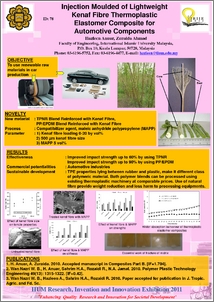Anuar, Hazleen and Ahmad, Zuraida
(2011)
Injection moulded lightweight kenaf fibre thermoplastic elastomer composite for automotive components.
In: IIUM Research, Invention and Innovation Exhibition (IRIIE) 2011, 9-10 February 2011, Cultural Activity Centre (CAC) and KAED Gallery IIUM.
(Unpublished)
![[img]](http://irep.iium.edu.my/style/images/fileicons/application_pdf.png)  Preview |
|
PDF (Injection moulded lightweight kenaf fibre thermoplastic elastomer composite for automotive components)
- Presentation
Download (1MB)
| Preview
|
Abstract
Thermoplastic elastomers (TPEs) blends have been developed offering various advantages and required no state-of-the-art processing machinery, while scrap and rejects are recyclable. The use of thermoplastic and elastomer however posses several limitations due to the increasing prices of plastics and natural rubber over the past few years. Hence, effort has been taken by combining kenaf natural fibres with thermoplastic elastomers. In this project, 20 vol% kenaf fibre was incorporated into thermoplastic elastomer. Two types of impact modifier were blended with polypropylene (PP) namely; thermoplastic natural rubber (TPNR) and polypropylene/ethylene-propylene-diene-monomer (PP/EPDM). Both composites were produced via double melt blending method using Haake internal mixer before they were injection moulded. The ratio of thermoplastic:elastomer was 70:30 for both polymer blends. Maleic anhydride polypropylene (MAPP) was added as a compatibilizer between matrix and reinforcement. The tensile strength for TPNR was about 12% higher than the PP/PPDM matrix. The present of kenaf fibre (KF) and MAPP however has significantly increased the tensile strength of PP/EPDM composite by approximately 81% while only 55% increment attained in TPNR-KF-MAPP as compared to unreinforced TPNR. Flexural properties and impact strength are greatly improved for treated kenaf fibre composite. MAPP has successfully forming a linkage bridge between kenaf fibre and polymer matrix thus enhanced of strength and stiffness of treated thermoplastic elastomer composites. Scanning electron micrographs (SEMs) revealed that the improvement achieved in mechanical properties was due to the interaction between both matrix systems and kenaf fibre.
Actions (login required)
 |
View Item |


 Download Statistics
Download Statistics Download Statistics
Download Statistics